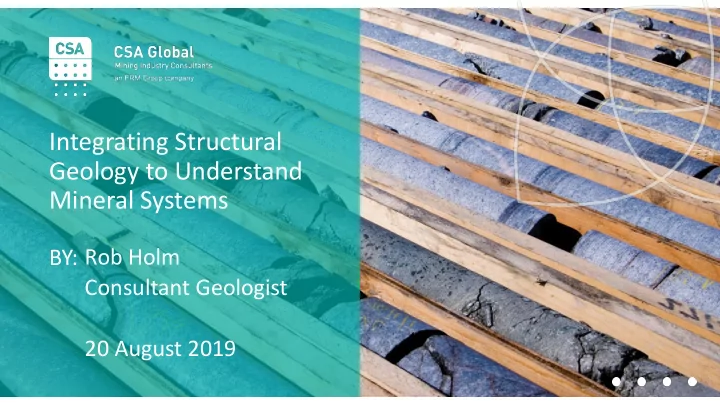

Integrating Structural Geology to Understand Mineral Systems Rob Holm BY: Consultant Geologist 20 August 2019
Mineral Systems Peters et al., 2017; Knox-Robinson and Wyborn, 1997
Components of Mineral Systems Ford et al., 2019; Knox-Robinson and Wyborn, 1997
Lithospheric-Scale Structure and Fluid Migration Bouguer Gravity e.g. Carlin province, Nevada Hronsky and Kreuzer, 2019; McCuaig and Hronsky, 2014 Hronsky and Kreuzer, 2019; Grauch et al., 2003 44
Cox & Ruming, 2004; Groves et al., 1989 Blewett et al., 2010 45 Blewett et al., 2010; Goleby et al., 2003
Terrane to Local-Scale Fluid Migration and Trapping Bierlein et al., 2006 Weinberg et al., 2005 Bierlein et al., 2006 46
Local to Deposit-Scale Fluid Migration and Trapping Cox and Ruming, 2004 Weinberg et al., 2004 Micklethwaite and Cox, 2006 47
Deposit-Scale Events and Traps? Blewett et al., 2010 Blewett et al., 2010 Doublier et al., 2014 48
Deposit-Scale Events and Traps? We cant rely on orientation alone to distinguish important structures and orientations. We need more than this from our data collection. 49
Deposit-Scale Structural Observations Jones et al., 2019 50
Deposit-Scale Structural Observations • Focus on observations rather than interpretation. • What are the key characteristics of structures we can use to classify and interpret them. • Make observations "Queryable “. • Get observations out of the comments field and into the data fields. • Recording of cross-cutting relationships are key to interpret timing. 51
Quality Control of Structural Observations In all stages of core orientation, mark up and measurement, accuracy is key. Record the confidence associated with different workflows. The accumulation of small errors over multiple stages can result in significant errors that can affect the quality of results. Non filtered bedding data Filtered, good bedding data Apparent folding (which is not real!) 52
Is a Vein Just a Vein? Veins need to be separated for structural analysis by their characteristics, as well as their orientation and mineralogy. For example, the vein characteristic could describe: • What does the vein look like internally? • What is the shape of the vein? • How does the vein relate to other similar veins? Vein abundance is important, but you don't have to measure every vein. Quantify similar veins by recording frequency. 53
Is a Vein Just a Vein? Vein Morphology Vein Connectivity All Veins Veins by composition Veins by composition + frequency Not very helpful or useful Helpful, but not statistically useful Helpful, and statistically useful 54
What About Other Structures? Faults, Folds, etc, etc Foliation Breccias Lineations Angular Slaty Structural Cleavage Intersections Sub-angular Crenulation Fault Cleavage Slickenfibres Sub-rounded Gneissic Fold Axis Banding Rounded 55
Migration Pathways, Traps and Mineralisation What is different about sites that host mineralisation compared to everything else around it? Like any other data set (e.g. lithology, geochemistry, geophysics), we are looking for a structural anomaly that may help to predict sites of mineralisation. Spatial domaining – domain by fault block, lithology, northing, easting etc. to recognise differences in statistical relationships between structures. 56 56
Migration Pathways, Traps and Mineralisation Within domain ppm Outside domain ll data ppm ppm ppm ppm ppm ppm Structural point data ssays interval above and Structural point data domained by grade cut o below grade cuto 57
Working Towards a Mineral System Understanding Once you have a dataset interpretations can be undertaken for Example mineral systems understanding: Vein populations Pre-Mineralisation Fold architecture Lode related Folds Fault architecture Architecture • Plunge and plunge direction • Position around folds Faulting/shearing Syn-Mineralisation (vergence) Fault Bends • dilation/fluid focussing Style of folding Fault stepovers Structural intersections Faults and shearing Post-Mineralisation • Sense of movement Folding deformation/ • Characteristics to Faulting/shearing recognise sets dismemberment Overprinting veins 58
Structural Geology in Mineral Systems Peters et al., 2017; Knox-Robinson and Wyborn, 1997
Principles of Structural Data Collection and Controls Ask me about our CSA Global Short Course 60
Recommend
More recommend